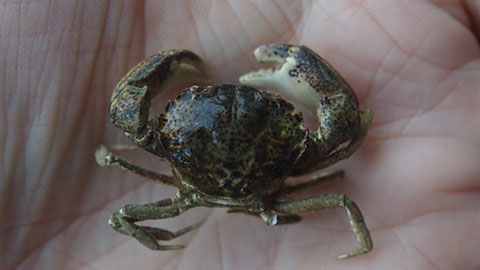Introduced Crab Species Reduces the Biodiversity in Kelp Communities
In a new study, the marine biologists of the University of Turku discovered that the white-tipped mud crab reduces the number of invertebrate species in kelp communities and diminishes biodiversity.
.jpg)
The North American white-fingered mud crab, introduced species that has invaded the Finnish Archipelago Sea and multiplied quickly, is a completely new type of species in the Northern Baltic Sea. The first crabs were found in 2009 near Naantali in South-West Finland and in recent years the species has spread quickly in the Finnish Archipelago Sea, almost all the way to the Sea of Bothnia.
Researchers of the University of Turku and the Marine Resources Research Institute in the United States have for the first time studied the possible impacts of the white-fingered mud crab on the local species in the Finnish Archipelago Sea.
Before the arrival of the crab, there were no other crab species in the Northern Baltic Sea, so it is a completely new predator to the local marine community.
Predatory White-fingered Mud Crab Reduces the Number of Invertebrates
The prey choice experiments conducted at the Archipelago Research Institute showed that the crabs prey invertebrate species native to the Finnish Archipelago Sea. The crabs prefer especially isopods and gammarid amphipods but they eat mussels as well. The researchers found it surprising how well the crabs caught mobile species.
In the field study, the researchers discovered that the crab reduces the number of invertebrates in kelp communities and decreases the communities' biodiversity.
– The crabs decrease the diversity of the kelp community by reducing the number of the individuals in the species they prey on. The species that the crab doesn't prey on, because of their small size for example, seem to benefit from the crab's introduction, says Doctoral Candidate Tiia Forsström from the University of Turku.
the diversity of the kelp community by reducing the number of the individuals in the species they prey on. The species that the crab doesn't prey on, because of their small size for example, seem to benefit from the crab's introduction, says Doctoral Candidate Tiia Forsström from the University of Turku.
Crabs Drive Away the Snails that Clean the Kelp
In kelp communities, the white-fingered mud crab has the greatest impact on river nerites, the snails that keep the surface of the kelp clean.
Researchers discovered that the kelp communities invaded by the crabs had even 40 percent less river nerites than the communities without crabs. Earlier studies have indicated that the river nerites were not killed by the crabs but that they abandoned the kelp communities to avoid being hunted.
– The most worrying aspect of our results is the scarcity of river nerites in the kelp communities invaded by the crab. River nerites are snails that take care of the kelp by eating the filamentous algae that grow on kelp. If the number of river nerites declines in the kelp communities invaded by the crab, filamentous algae starts to cover the kelp faster and easier than before. This might slow down the kelp's growth and even reduce the abundance of kelp in those areas where the crab exists.
Kelp is one of the key species in the Baltic Sea as it offers a habitat and food to many small fish species and marine invertebrates.
– However, it should be kept in mind that the laboratory and field experiments give a somewhat one-sided image of the crab's impact on other species, as the crab has its own predators in the nature. In the Finnish Archipelago Sea, many fish species hunt the crabs and therefore diminish the preadatory crab's impact on the kelp communities, says Forsström.
The study was published in the Biological Invasions science journal: http://link.springer.com/article/10.1007/s10530-015-0909-0/fulltext.html
Text: Liisa Reunanen
Translation: Mari Ratia